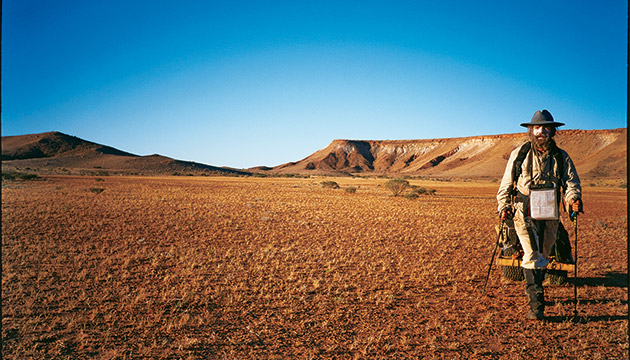Mountaineer and explorer Jon Muir has just completed an epic solo walk from the edge of Australia into its heart, on a journey of his inner and outer worlds.
Story By Suzan Muir
Australia’s Red Centre has always held a mysterious attraction. Early explorers struggled north from the coast in the hope that they might find an inland sea or greener pastures and even today people from all over the world make the pilgrimage there, lured there by the domes of Kata Tjuta and the mythological monolith of Uluru.
My husband, mountaineer and polar explorer Jon Muir, was also captivated by the idea of making a journey to the centre of Australia. His idea though, was to travel there on foot – to begin his march at the coast and to walk, unsupported, to the tidal center of the country (the point furthest west from the sea in all directions). Thirty years of experience in surviving extreme environments was a solid basis from which to launch into such a potentially dangerous journey.
For many years Jon has been drawn to challenging adventures, which have been as much an exploration of his inner world as they have been of the landscape through which he has travelled. He seems to revel in those times when the going is toughest, when he has to dig deepest into all his inner resources, to pull himself through a particularly odious physical situation. In Jon’s own words, “When you are functioning at that most basic level, of pushing hard to survive, you get to experience the full extent of your own physical and metal strengths and there is such a simple pleasure in this. No energy is left over for anything superfluous, the mind being totally absorbed in the task at hand.”
Some of Jon’s most notable journeys have inevitably involved that deep inner exploration. They include his 1500-kilometre route to the South Pole with Eric Philips and Peter Hillary in 1998 and a 1000km unsupported walk to the North Pole in 2002. In between the two he completed a solo trek – the first unsupported walk across the continent – from Port Augusta in South Australia to Burketown in the Northern Queensland. For 2500km Jon pulled a wheeled cart loaded with 160 kilograms worth of basic food rations, camping gear, gun, maps and compass and water. It was a gruelling journey made possible by 11 years of both study and practice in the hunting and gathering of bush foods, and in locating water in a seemingly waterless land.
Jon had lost one third of his body weight by the time he reached the Gulf of Carpentaria at the end of his four-month odyssey. His most recent walk, which he completed in July, took just 10 weeks to cover 1700km. He started from tidal salt water at Port Augusta and continued up the west coast of Lake Torrens. He turned north-northwest to hook into the terminus of the Finkle River in the Simpson Desert and followed the course of the Finkle to its source and across the MacDonnell Ranges to what South Australian explorer and geologist Cecil Thomas Madigan referred to as the “Tidal Center”, 35km north of Mt Zeil, at the end of the ranges.
He marched for 70 days without a single rest day. Without really knowing why, Jon had felt compelled from the beginning of his walk to push hard. As the journey unfolded the reason become apparent. Several proceeding years of drought had devastated resources of bush food and sustenance was hard to come by. Plenty of lean rabbit and kangaroo meat caught be obtained but not much fruit or starch for energy. He felt that if he had allowed just one more week to achieve his goal he would not have finished the walk. I knew he would start to have real trouble when he rang on day 50 with the news that he had lost all of his body fat. From that time onwards his body would be breaking down his muscle to fuel his relentless push forward. Starvation sets in quickly when you start to consume your own muscles.
When Jon finished he was emaciated and hollow and had nothing left of the meager carbohydrate rations he had carried with him. There was only a few days grace between achieving his objective and not be able to continue due to starvation.
This story excerpt is from Issue #55
Outback Magazine: Oct/Nov 2008









